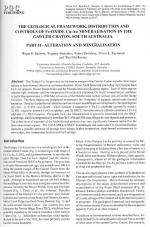Добрый день, Коллеги. Важное сообщение, просьба принять участие. Музей Ферсмана ищет помощь для реставрационных работ в помещении. Подробности по ссылке
The Geological Framework, Distribution and Controls of Fe-Oxide Cu-Au Mineralisation in the Gawler Craton, South Australia: Part II - Alteration and Mineralisation
The Olympic Cu-Au province on the eastern margin of the Gawler Craton includes three major regions of hydrothermal alteration and mineralisation: Stuart Shelf basement (including the Olympic Dam Cu-U-Au deposit), Mount Woods lnlier and the Moonta-Wallaroo-Roopena region. Each of these regions contains high-, moderate- and low-temperature Fe-oxide rich alteration, Cu-Au+U mineralisation, and felsic to mafic Mesoproterozoic (-1590 Ma) intrusions of the Hiltaba Suite with or without coeval Gawler Range Volcanics. The three regions are interpreted to represent the 'footprints' of separate crustal-scale thermal anomalies. Three key hydrothermal alteration and ore mineral assemblages are recognised in the metallogenic province: (1) CAM: calcsilicate - alkali feldspar ± magnetite ± Fe-Cu sulphides (generally minor); (2) MB: magnetite-biotite + Fe-Cu sulphides; and (3) HSCC: hematite-sericite-chlorite-carbonate ± Fe-Cu sulphides ± U, REE minerals. Ore grade Cu-U-Au mineralisation is generally associated with the HSCC assemblage, which is paragenetically later than the CAM and MB assemblages in most deposits and prospects. The crustal level of exposure of the hydrothermal systems may vary significantly between and within the three mineralised regions. The CAM, MB and HSCC assemblages and associated Cu-Au mineralisation represent a possible spectrum of settings from deeper, higher temperature, shear-hosted environments to near-surface, low-temperature breccia and fault settings.




